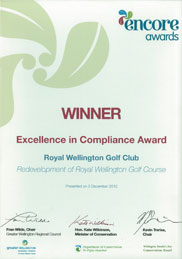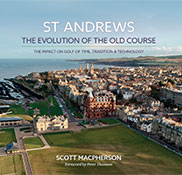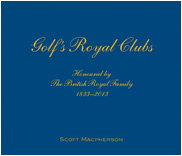GOLF CHAMPIONSHIPS ON SMGD COURSES:
At Close House – Colt Course. Sept 2017. A prestigious European Tour Championship hosted by Lee Westwood.
Broadcast worldwide from Royal Wellington Golf Club, NZ. October 2017. WOW!
The legacy continues.
Co-hosted at the award-winning Millbrook Resort near Queenstown, NZ. 2014 – 2023.
The Ideal Opening Hole
Sept 2006.
Some perceive the first hole should offer a warm welcome to the course, while others propose differently suggesting the best golfing test should begin in earnest on the first tee with a demanding first shot. I like to think the first hole should be like the first paragraph of an essay or the first chapter of a book. It must set up the story and introduce some characters. It should not mislead us, offend our sympathies, bruise our faith or kill our optimism.
To me, it is important that on the first tee a player can see two things: the first landing area and green. My reason for this is three-fold- firstly it speeds up play and prevents golfers immediately hitting into the group in front of them. Secondly, it allows golfers to see the placement of any hazards and decide a pay strategy. Thirdly, on courses that welcome visitors, being able to see the first green gives the first time visitor a clear direction in which to play and significantly reduces the evil of slow play.. This sounds straight forward, and yet on a surprising number of courses they do not have one or two or all of these features?
Look at the first hole at the highly respected Paraparaumu Beach golf course in New Zealand. Here the first drive is over the brow of a hill to a hidden landing area and the green further tucked behind a dune to the left? Even the members don’t know when the landing area is clear. A hole such as this may be fine in the middle of the course but as a starting hole it is not ideal. Indeed Tiger Woods was so bemused with how to play the hole that during the NZ Open, he eventually decided to just hit his driver and go for the green (a feat he achieved, I might add)
The first hole at PBGC may fall foul in regard to another feature also- the forced carry. Many architects perceive this as a poor feature on an opening hole. It rarely punishes the proficient player but can severely hamper the higher handicapper. Proper tee spacing can go some way to remedying this situation, but the feature may still not be ideal on the opening hole.
I believe the first hole should be a dogleg. (Indeed, all holes should have some ‘kink’ whether real or inferred). It matters not whether the hole plays left or right, but it should not be dead straight. Some have proposed they favour holes where the green is raised, or a downhill hole, but it is spurious to decide this until a site has been studied and the Clubhouse location nominated. To me, either works fine and ultimately, the terrain will indicate where the green should lie.
Not all doglegs are ideal though. The changes made to Royal Liverpool (Hoylake) for the 2006 British Open make an interesting case study. The hard dogleg right Par 4 hole regularly used as the first hole was not favoured for use in this position by the R&A Championship Committee. Instead the course was renumbered with the tradition 17th and 18th holes moved to the front and played as one and two. The regular first hole became the third. Why? I am sure there were infrastructure reasons, but perhaps the fact that the hole is flanked closely down the right side by and internal Out-of –Bounds may have contributed too.
In terms of length, ideally the first hole should not be a Par 3. Of course there are some famous courses where the first hole is a par 3- perhaps most notably the first at Royal Lytham St Annes. But these are not deemed ideal.
Tom Doak, architect of Cape Kidnappers, likes the idea that the first hole should not be impossibly difficult. In a recent conversation he shared his philosophies and when it came to opening holes, he didn’t like the idea that a player might start the round by writing a 6 (Double bogey) on there scorecard. Architects cannot however be directly responsible for a players score- that would be claiming far to much credit.
Renown architect Donald Ross (Pinehurst, Seminole) thought that it best not to make the opening holes too difficult so a player could ‘warm up a bit and get the swing of his stroke well under control’. If the first hole was too difficult he thought it would contribute to congestion. However after the first two holes it was OK to ‘give him some real tough nuts to crack’. He thought the first hole should be about 400 yards long if a suitable green site was available at about that yardage. Out-of bounds was a ‘beastly nuisance’ and should be avoided. If it can’t be, try and make holes play up to it rather than along it. This will elevates ‘delay, loss of ball, vexation and even profanity’.
While I feel a good first hole has key ingredients, there is no one recipe. But, with good designs, form follows function. Therefore the ideal first hole should get play away, engage the golfer and must fit the terrain. Just like a good host offers a warm welcome, so should a good opening hole. A generous fairway should be extended to the golfer and– like a swimming pool on a hot day – the sight should be so tempting, you feel compelled to play.
AWARDS
 Winner
Winner
Excellence in Compliance Award
Royal Wellington Golf Club
 Scott awarded by GEO as a Sustainable Golf Champion
Scott awarded by GEO as a Sustainable Golf Champion
PUBLICATIONS
 St Andrews
St Andrews
The Evolution of the Old Course
by Scott Macpherson
TESTIMONIALS
"During both the design and construction phases their can-do attitude to problem solving was refreshing".
Ben O'Malley, Millbrook Country Club, NZ



